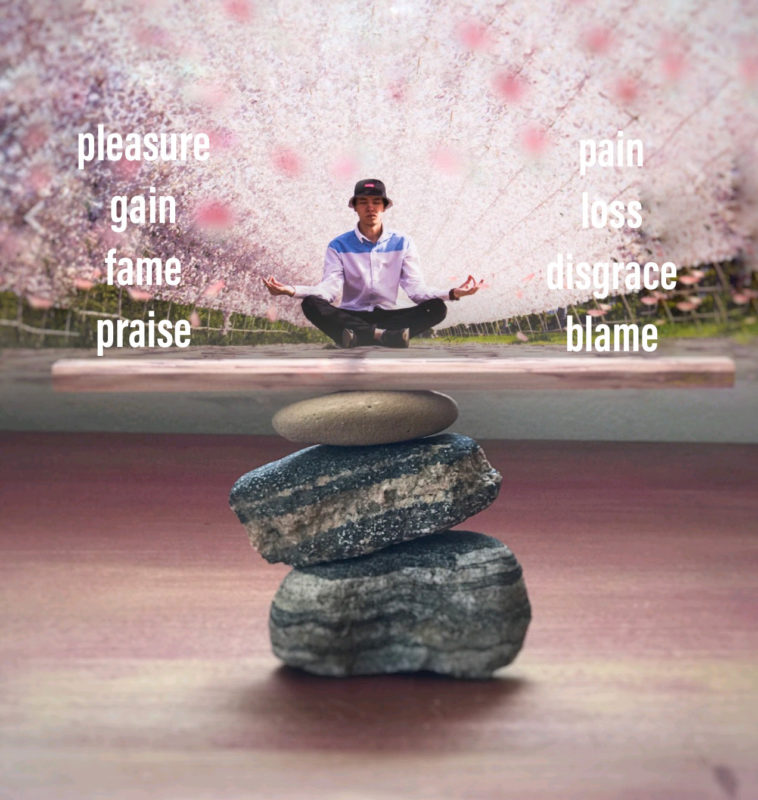
This is the fifth of twelve posts in the Exploring Mindfulness blog series, a reflection on the book When Things Fall Apart by Pema Chödrön. This post addresses Chapters Eight and Nine. Participants are encouraged to practice mindful meditation daily throughout the twelve weeks, even if for five minutes at a time. (7 min read)
The word “equanimity,” it seems to me, best captures the balanced state that we seek to develop through the Buddhist teachings “Eight Worldly Dharmas” in Chapter Eight and “Six Kinds of Loneliness” in Chapter Nine. One could describe equanimity as mental and emotional equilibrium. Equanimity is peacefully walking the middle path between the desires that draw us on one side and the aversions that make us want to flee on the other side. Before discussing these two teachings, I wanted to say a few things about mindfulness in general.
~*~
I find it helpful to think of mindfulness in a practical way. Let’s say you have a friend who has a knack for home repairs. He reaches into his battered toolbox, pulls something out, and as he hands it to you, he says, “Here. You may find this useful”. He doesn’t say, “This is what you need to be good at home repair,” or “I can’t believe you don’t know how to do it.” Similarly, I would like to say to you, “You may find mindfulness useful for experiencing your thoughts and emotions in a way that will prevent unnecessary suffering.”
If you’re like me, you will probably need your friend to show you how to use the tool, and you may even need to practice. The same is true of mindfulness. If it were merely a matter of describing mindfulness When Things Fall Apart would be a very short book. It may read something like this:
When Things Fall Apart: Be aware of the world as it is in the present moment, without judgment but with loving-kindness toward yourself and others. The End.
The books as Pema has written it is, essentially, a collection of explanations, anecdotes, metaphors, and various major and minor practices to help us shift our thinking and behavior as we face our feelings.
One metaphor that Pema introduces in Chapter Nine is “touching a bubble with a feather”. She encourages us to have a warm and friendly attitude toward whatever arises in our mind—even those unbidden thoughts that we may feel are ruining our mindfulness. She tells us that whatever arises that,
we usually call good or bad we simply acknowledge as ‘thinking’, without all the usual drama that goes along with right and wrong. We are instructed to let the thoughts come and go as if touching a bubble with a feather. This straightforward discipline prepares us to stop struggling and discover a fresh, unbiased state of being.
~*~
EIGHT WORDLY DHARMAS
I have created a graphic depiction of the Eight Worldly Dharmas, based on how I visualize the teaching.

The meditator in the image represents mindfulness. The meditator sits on the fulcrum—the only point on the entire plank where there is equanimity. On the left are the things we like and become attached to, and on the right are things we dislike and try to avoid. The ones on the left are not good or superior, and those on the right are not bad or inferior. They are equal in value and importance, because they are just things that come and go, as is the nature of life. It is not the things in and of themselves that create disequilibrium, but our attempts to grasp the things we like or push away the things we don’t that will tip us over. When we acknowledge each as they are, we enter the state of equanimity.
~*~
SIX KINDS OF LONELINESS
One way that Pema helps us to see and experience things in different ways is to have us look at emotions in detail and with an eye to subtle aspects of a particular emotion. We are encouraged to experiment with cultivating a different relationship than what we have typically had with even our most painful thoughts and feelings.
Her instruction on Six Kinds of Loneliness addresses one such painful emotion. She explains that loneliness is usually experienced as “restless and pregnant and hot with the desire to escape and find something or someone to keep us company.” This she calls hot loneliness. When we cultivate a different attitude and relationship with our loneliness, she describes this as cool loneliness. This, she writes, “completely turns our usual fearful patterns upside down.”
A friend told me of an experience of being alone that illustrates the heat and coolness of loneliness. I spoke with her after I was asked to write a piece for a community blog about the impact of coronavirus. For my article, “Living Alone During a Pandemic”, I interviewed several people, including my friend. I asked her if her experience of living alone had changed since the quarantine. She answered in a way that surprised me. “It has changed,” she said, “in quite a lovely way.” She paused then added, “but it was painful because I was faced with what I call my own underbelly—wounds, and vulnerability.” Near the beginning of the quarantine, painful emotions regarding a recent breakup arose and sharpened. She explained that it rekindled an old familiar pain of “being left behind” from past losses. Though it was she who left and though she knows it was the right choice, the stay-at-home order came “before I got to reintegrate into the world without being a partnered person.” She observed that she could have very easily distracted herself in the ways we all do, drink, eat, etc. “I said to myself, I don’t want to drink, get fat, or fight with anyone!” By refraining, her loneliness cooled.
Here is a summary of the six ways of describing cool loneliness:
- Less Desire is the willingness to sit with our loneliness even as we yearn for something to relieve it. Pema writes,
After we practice Less Desire wholeheartedly and consistently, something shifts… So even if the hot loneliness is there, and 1.6 seconds we sit with that restlessness when yesterday we couldn’t sit for even one, that’s the journey of the warrior.
- Contentment. Contentment is living with the uneasiness that comes when we give up on “happy ever after,” We give up on thinking, if only we were with the right person at the right place, we would be happy. Pema writes,
Usually, we have to give up this belief about a billion times… with awareness. Then without even noticing, something begins to shift. We can just be lonely with no alternatives, content to be right here with the mood and texture of what’s happening.
- Avoiding Unnecessary Activity. When loneliness is heated, it fuels a frantic search for a way out or for something to save us. We may create busywork, create drama through gossip, or get caught up in fantasy or obsessive thinking. Pema writes,
The point is that in all these activities we are seeking companionship in our usual, habitual way, using our same old repetitive ways of distancing ourselves from the demon loneliness.
- Complete Discipline is the practice of coming back to the present moment and coming back again to the present moment with patience and no judgment, cultivating cool loneliness even as the hot loneliness sends our mind elsewhere. There is no need to cultivate this type of loneliness because it arises naturally as part of human experience. We don’t need to invite loneliness or push it away. We don’t have to like it. But we are wise to allow ourselves to experience it when it arises.
- Not Wandering in the World of Desire. We desire food, drink, people, sex, etc. It is not these things, per se, that are the problem. It is the desire for them that is problematic. Desire brings us away from the moment; desire is so often about running from an uncomfortable moment. Desire puts us at considerable risk of attachment to the thing that we desire. Think of wandering into desire as the remnant of the small child within us that wants mom to take care of things. Not wandering into desire is to be orphaned and homeless. It is to discover that you are okay without a mom or a home because loving-kindness toward yourself is the mother and the home within you.
- Not Seeking Security from Ones Discursive Thoughts. Discursive thoughts are the rambling and digressive thoughts that arise naturally. There is nothing wrong with them but we easily get taken away by them. Cool loneliness is not to expect that our constant internal chatter will give us security. Pema explains that we don’t need to talk “with ourselves about how it is and how it isn’t, whether it is or whether it isn’t, whether it should or whether it shouldn’t, whether it can or whether it can’t. [The chatter] has no objective reality. We’re encouraged to just touch that chatter and let it go, not make much ado about nothing.”
~~~~~*~~~~~
Exercise:
Before beginning, read the two sets of metaphors—not grasping and not avoiding. Pick two or three to focus on during the exercise.
Metaphors for not grasping any thoughts that arise:
- Touching a bubble with a feather
- Clouds passing over a clear sky
- Waves on a beach
- A barge floating down a river
- A butterfly alighting on a flower and flying away
- Your own metaphor
Metaphors for not avoiding strong emotions that may arise:
- Turn around and face the emotion (anxiety, loneliness, sadness) that is following you. Look it in the eyes and ask, “What do you have to teach me?”
- Pay attention to a particular emotion. Notice it’s heat—it’s urgency. As you stay with it, imagine it cooling.
- Notice where a specific emotion is within your body. Feel its intensity or firmness. As you stay with it, notice if it shifts or softens.
- Your own metaphor
Seat yourself for meditation. Be aware that you are sitting. Next, follow your natural breath for a few moments.
Choose a metaphor for not grasping to focus on for a few moments. Next, choose a metaphor for not avoiding. After two or three of each, focus on your breath a few moments more before ending.
Thanks for participating!
ॐ I bow to you,
Perry
~~~~~*~~~~~
Next Post: 6/7/20 and will focus on Chapter 10.
To find out more about the series or to participate in the discussion, go to Welcome to the Exploring Mindfulness Series.